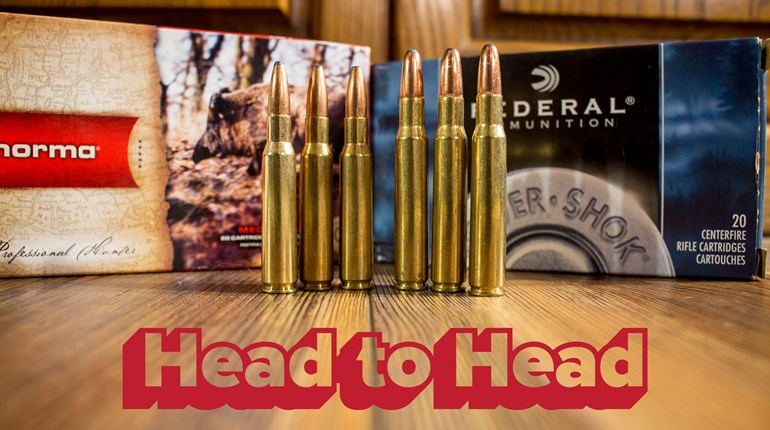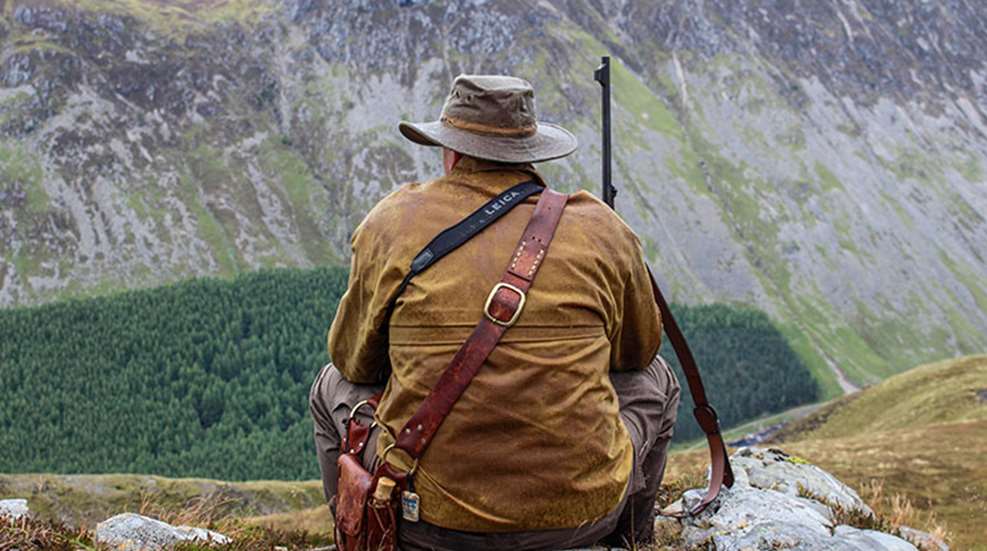
The rain was coming slightly from the side, and it was interspersed with banks of fog and mist so thick seeing 50 yards in front of us was a near impossibility. There were four of us in the party that morning in the Scottish Highlands: your narrator, his wife, Suzie, Italian gunwriter Massimo Vallini and our stalker on the Blair Atholl Estate, Ronnie Hepburn. We were part of a dozen or so members of the gun industry called from around the globe to celebrate the official hunting release of the Rigby Highland Stalker rifle, and no detail of the experience was overlooked.
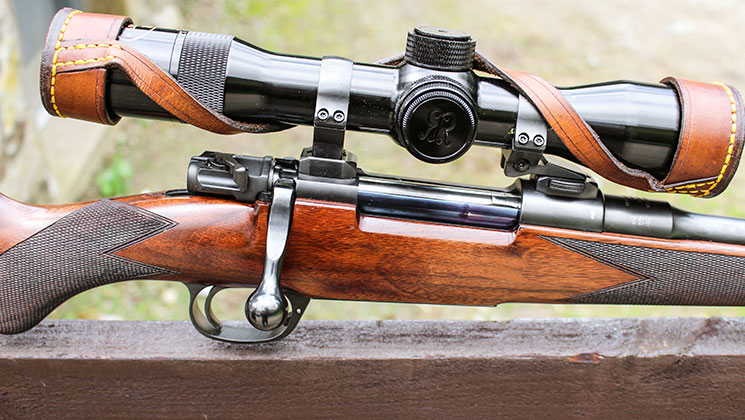
The event had commenced at the Rigby shop on Pensbury Place in southwest London, with a tour of the shop and its rich history, replete with original archives of rifle work and repairs dating back to 1780. An overnight train ride on the Caledonian Sleeper terminated at the Blair Atholl Estate, surrounding its famous castle. As we were greeted by the sound of Scottish bagpipes at the rail station, I realized there was no doubt about the grandeur of this event.
Once our gear was stowed in the Old Blair lodge, we changed into hunting gear and headed for the rifle range. A few shots with the Highland Stalker verified zero (our shared rifle was chambered for the .30-06 Springfield), and we made our way to the hills to stalk and shoot red stags.
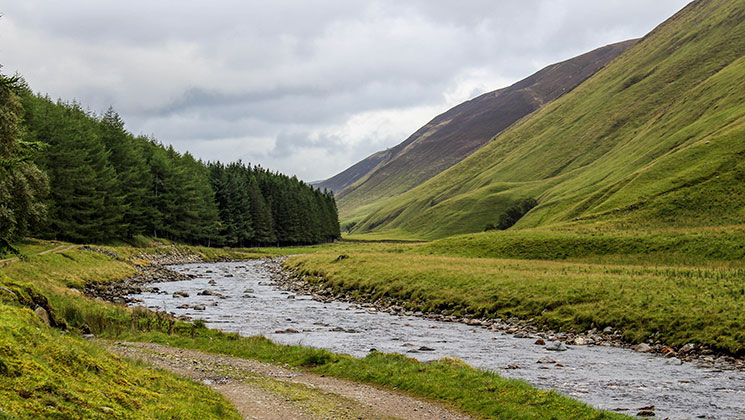
“This weather is absolute sh!@#,” said Hepburn. He’s a veteran stalker who knows his hunting block of the Blair Atholl Estate like the back of his hand, and he was not at all pleased with the conditions. The wonderful alternating combination of pouring rain and pea-soup fog made for less-than-desirable hunting conditions, but we were eager to hunt, and Hepburn wouldn’t let a “wee bit o’ weather” hold him back.
“Let’s take a walk down toward the river, where the mist is less, and take a look at those lower corries,” he said.
A corrie is one of the flatter areas between the steep side banks that rise from a stream or river. Any of them may have been filled with red stags for all I knew—we couldn’t see far at all. Small hilltops would appear as the rain came down hard, only to disappear when the fog rolled in. I let Vallini have the first shot, as I had never laid eyes upon a red stag. I sort of wanted an opportunity to see it done once, in order to get a feel for the size and behavior of these grand animals. Scottish traditions run deep—especially when it comes to stalking—and I was new to the game.
Dressed in the local tweed pattern, designed to be a sort of camouflage among the heather and grass, the stalker is responsible for locating the herd, choosing the animal to be taken and carrying the rifle until the shot is set up. Yes, it’s different from our deer or elk hunts, but hey, when in Rome …
During a break in the fog, Hepburn threw up his Leica, immediately traded it for the higher-power telescope most stalkers carry in a well-worn leather case then got very excited. “There’s a small herd on the side of that far hill; one o’ them has a decent head,” he exclaimed.
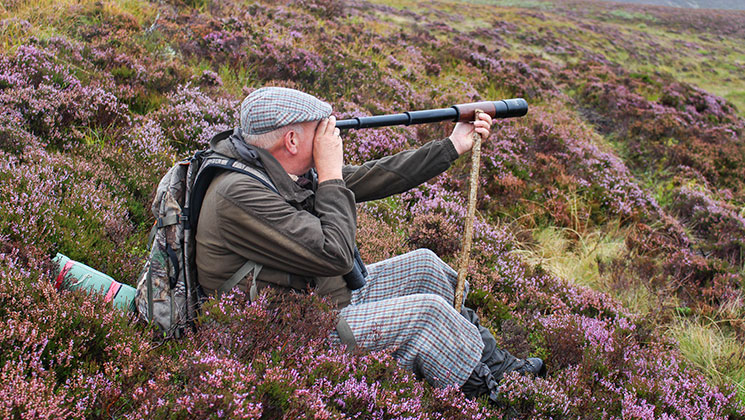
Well, the lousy-weather day immediately got better. But when Hepburn finally talked me to the spot where he saw the stag, I realized any approach would be nearly impossible. The wide-open terrain that allows for easy spotting also precludes a simple stalk—unless you use the terrain, and that was Hepburn’s exact plan.
Sheep are a Scottish staple, feeding on, over and around the hillsides, mingling with the red deer and leaving the faintest of little tracks that use the contours to their advantage. Soaked through to the skin in spite of good gear, we used the little sheep trails to get under the skyline and make an approach to the herd the stalker had spotted. “Difficult, but not impossible,” he noted, “and we’re nae goin’ ta shoot one from the lodge.”
Some of those sheep trails ran along inclines so steep that if one were to slip off the trail, one would more than likely break one’s neck in the process of obeying the law of gravity. Nonetheless, our merry little party made progress toward the herd; the wind (and rain) was certainly in our favor, and the fog had begun to lift a bit when Ronnie stopped us on the leeward side of one of the little hillocks the Scottish refer to as a “bump.”
“I’d ask you and the Mrs. to wait here while we make an approach,” said Hepburn. “The terrain flattens a bit and the stalk may be difficult.” That was no problem, as my legs were screaming and I had some dainties in the camera bag to nibble on, anyway. But during the wait Suzie—who does a fair amount of camera work—informed me the camera bag and its contents were rather soaked. So we were eating wet lemon cakes and trying to figure how to dry the camera when I heard two unmistakable sounds: the report of a rifle and the resulting bullet striking flesh.
This point in time also marked our first encounter with another Scottish tradition: the midges. A Highland midge is similar to our blackfly, if that blackfly was built like Arnold Schwarzenegger in his prime and had a methamphetamine problem. Having a bald head, I must have seemed like an all-you-eat buffet. When the wind died down, the midges rose from the heather in battle formation, ready for attack.
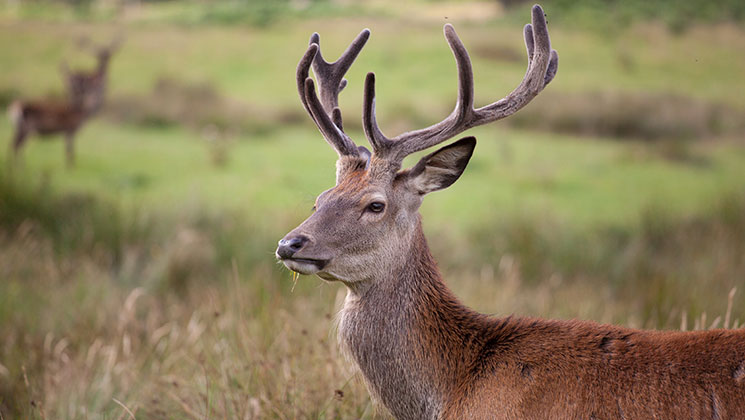
Hepburn returned and told us Vallini had hit his stag, but it required finishing. Once Vallini sorted out his deer, he stood—proud as a peacock—over a 10-point stag with double crowns. The red stag is, genetically, nearly identical to our American elk, though in the Highlands one rarely reaches the body size or antler proportion our wapiti possesses. At the end of the antler, the red stag produces crown points, usually a three-point cluster in the better specimens; Vallini’s stag was definitely one of the better examples for the area.
Hepburn opened his kit, and began to gralloch the stag. (Gralloch is a classy word for gutting, and I believe I’ll add it to my vocabulary; it gives a nasty job a bit of a shine.) As the venison was destined for market, Hepburn adhered to a strict procedure, and with a surgeon’s precision eviscerated the noble beast, which would be delivered to the Land Rover by his young assistant, Tim.
“Phil, I don’t believe the herd has gone very far; the wind is rather strong and we can have a look at them just over that knob,” said the stalker.
Well, if “just over that knob” was a mile or two away, Hepburn was right. We blew one stalk on a good, lone stag, and the afternoon began to wear on. My hopes waned, my feet squished, rain dripped off my nose, but still Hepburn persevered. We walked and walked some more, covering those beautiful hills as the rain began to let up. Using the subtle folds in the heather-covered slopes, my stalker stopped short: “Just here!” he hissed. “There’s a huge herd just here!”
We all assumed that classic stooping position as we reached for our binoculars, and discussed the situation. “Easy, rise up easy and have a look,” instructed Hepburn. And through my Leica, I saw what he saw: a herd of 40 or 50 red deer, with several good stags in the mix. “Let’s get up behind that bump and get into position,” said Hepburn. “We’ll have to go very slowly; they’re goin’ ta feed right into us.”
On our bellies, we slithered through the heather until we could just see over the rise; indeed the herd was closing the distance. At the rear of the herd, just a bit left of center, was an older stag with good horns and a black coat. Ronnie whispered, “He’s been rollin’ in the peat bogs. I think that’s the stag we need to shoot.”
Lying semi-prone against the slanting hillside, I made a makeshift rest out of a combination of the royal-blue Rigby soft case and the rolled, foam rest all the stalkers carry.
“Are you comfortable with this shot?” Hepburn asked. I double-checked the fore-end support: “How far do you put him?” I inquired. Ronnie produced a rangefinder: “225 meters.” Giving a couple inches of elevation to allow for drop, I held on the stag’s shoulder and waited for a hind to feed away from the bullet’s path. “Take him as soon as she clears out,” said Hepburn.
I relaxed my shoulder muscles, and gave the half-exhale to steady the crosshairs in the Rigby scope, thoroughly fogging the rear ocular. The wet conditions were not exactly working out well for me. To add insult to injury, as I wiped the rear lens the wind died, bringing the 32nd Airborne Midge Division from its hidden stronghold to lead a full-on attack on this writer’s noggin. (How can anyone shoot with these damned things?!) But in spite of looking like Pigpen in a Peanuts cartoon, I got the crosshair on the inside of the stag’s shoulder, as he had quartered to us, and broke the sweet trigger of the Highland Stalker, sending a 165-grain Hornady InterLock Spire Point on its way. I couldn’t see the stag’s reaction through the recoil, but the sound of the bullet hitting was unmistakable.
“He dropped like a sack of flour!” exclaimed Hepburn.
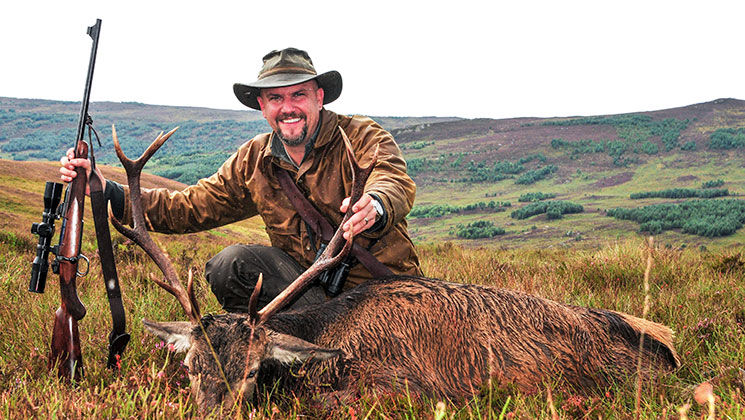
I freed the midges held prisoner in my ears and eyes, saw the stag kick, rise for an instant … and fall for the last time. Eleven points, including double crowns, adorned the head of this magnificent animal. Hepburn was elated. I was equally humbled and excited to join such deep-rooted tradition. Once properly gralloched, we took the stag across the river to the four-wheeler that would transport him to the Land Rover. Horrible weather, a new rifle and two stags down: I’d say we absolutely made the best of a bad day.
Returning to the lodge thoroughly soaked to the bone, we were welcomed by a warm fire in the hearth and a dram of Rigby’s whisky—perfect for a hunter exposed to the elements. We grabbed a hot shower and a dry set of clothes and piled into the Land Rovers to join the other half of the party at their lodge for dinner. A delicious meal of rabbit, homemade bread and the trimmings was followed by another drink by the fireplace and the telling of the day’s stories. To be among my peers, from so many different countries and continents, was certainly special, but to hear the hunting stories of everyone’s experiences at a place as unique as Blair Atholl was nearly surreal. In the tradition of so many British and Scottish hunters, the hunt had brought us all together. The topic invariably turned to the Highland Stalker rifle, and while we were all singing its praises, Marc Newton, managing director of John Rigby & Co., asked if we’d all like to see an extremely special rifle. Well, hello! Of course.
From of a Rigby slip case Newton produced a battered old bolt-action rifle, with virtually no bluing left on any visible metal surface and a worn, yet stunning stock. He had my undivided attention. When he turned the left side of the rifle toward me, the flash off the silver medallion told me exactly what I needed to know: It was the same rifle owned and used by Col. Jim Corbett to eradicate so many man-eating tigers and leopards. To hold it in my hands was an absolute honor. I stepped away from the crowd, brought the rifle to shoulder and leveled the sights on an imaginary man-eater. I was on cloud nine.
The next day was spent accompanying Newton on a hunt in a different area, with some sunny weather and a good view of the beautiful Highlands—if that place doesn’t make you feel alive, you need to check your pulse). That evening we gathered again not in a lodge but for a black-tie dinner at the Blair Atholl Castle, home to the only other standing army beside the British Army: the Atholl Highlanders. Among the medieval weaponry and vintage stag horns, we exchanged stories over a fantastic venison dinner. Several vintage Rigby rifles made the centerpiece, tying together the traditions of fine gunmaking and highland stalking in a very classy package. John Rigby & Co. is back in London (where I feel it belongs), and the company has embraced both its roots and its future. The Highland Stalker rifle is a tangible example of this fact, but this hunt, and the camaraderie that resulted from it, is an intangible that will remain with me for life.

The Rigby Highland Stalker
Paired once again with Mauser, John Rigby & Co. has introduced a rifle highly reminiscent of the pre-war units that came out of its shop.
The Highland Stalker uses a Mauser barreled action, true to the originals in design with the exception of the stripper clip cutout and thumb curve, as laws currently prevent the importation of military actions. To this Rigby added a svelte, sweet-handling stock of proper proportions. The standard grade of walnut is prettier than most rifles we Americans are accustomed to, but the upgraded wood can be absolutely stunning. A graceful pistol grip, with an open curve, is capped with a rounded grip base and simple, yet completely useful checkering. Appointments are equally useful and attractive: a barrel-band sling stud; a hinged floorplate; an innovative, adjustable front sight; a fixed rear sight with two folding leaves; a three-position wing safety; and a well-tuned trigger.
The Highland Stalker is drilled and tapped for a riflescope, yet the iron sights work well: We produced some impressive 100-yard groups at the range. Weighing a shade less than 8 pounds, it is offered in .275 Rigby, .30-06 Spgfld., .308 Win., 8x57 Mauser and 9.3x62mm, and with a base price of about $9,000, it is destined to become a family heirloom for generations to come.
I’ve shot Rigby rifles that are more than a century old, and they function just as fine as the day they were made; the Highland Stalker is destined to provide the same level of performance. It’s no mass-produced rifle. It bears the touch of those craftsmen who occupy the Pensbury Place shop, and that is immediate upon inspection. The wood-to-metal finish is impeccable, in fine British tradition. When I think Rigby, I think tradition. Jim Corbett, Denys Finch-Hatton, W.D.M. Bell and Harry Selby all relied on a Rigby rifle, and their exploits became the material for so many of the hunting stories we all love. MSRP: $8,995; johnrigbyandco.com.














